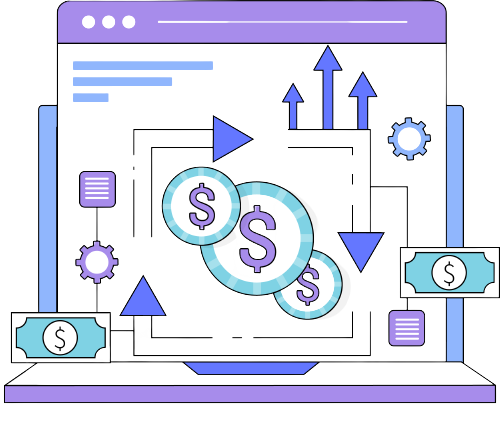
In this section, I will share the cash flow story of an entrepreneur with you.
You will learn to manage cash flow better during business growth through this story.
In Feb 2020, a new client, let’s call her Kay, approached me via a mutual connection. She has a high-end beauty parlor business based in London.
Our conversation went like this:
Kay: “Shishir, I have made money in my business, and still my business is about to go bust.”
Shishir: “What do you mean, Kay?”
Kay: “Well, I have made money, but also I haven’t. My clients owe me £57,550. I need to pay my staff and suppliers £27,950 this week, and I don’t have the cash to do that. My sales have grown every quarter for the last six quarters, and still, I always struggle with cash flow. It’s a nightmare. Can you help? What should I do?”
I’m sharing an updated and structured version of what I told Kay in this section.
You will understand the relationship between cash and business growth by the end of this.
You will also learn best practices you can implement for smooth business growth.
Let’s start by understanding how cash and business growth are connected. Then, I’ll try and share more than what you intuitively know.
Relationship Between Cash and Business Growth

Have you ever experienced problems keeping cash in your business despite increasing sales?
If yes, then your business may have become a cash-consuming blackhole.
It happens because as you grow your business, you need to invest in:
- Hiring people like VA, bookkeepers, accountants, and other employees
- Space for meetings and events at times
- Marketing to keep your brand relevant and ads to drive traffic
- One-off costs like new computers, office supplies
Before you know it, your fixed expenses jump. And, your business starts bleeding cash.
In the beginning, it feels manageable. But when a business cannot sell enough to cover increasing expenses, it starts getting out of hand. This hurts cash flow badly.
The same happened with Kay, who I mentioned earlier.
She had £57,550 as debtors, but she needed to pay £27,950 towards salaries and suppliers in one week. However, her debtors wouldn’t have settled in one week, as the balance was not due yet.
If you are in a similar situation, I am sharing cash flow management best practices to avoid usual challenges in business growth.
5 Best Practices to Have Smooth Business Growth By Way of Cash Flow Management
When growing your business, you need a solid financial foundation. Otherwise, your business may not survive for long, as 90% of businesses do not survive more than five years, out of which 82% fall short because of cash flow problems.
To make it work, pay always have a grip on your cash flow. I am sharing five best practices that will help you do that.
2. Prioritize Cash Generating Activities
Cash is more important than profit when scaling.
Profit is worthless when you struggle to pay your employees, taxes, and even yourself.
So prioritize cash-generating activities. Before doing anything in business, ask yourself, “how is this going to affect my cash flow?”
2. Know Your Numbers
Do you know one of the reasons why Warren buffet is so successful?
He reads financial statements and does his research to know all about the company he wants to invest in. By the time he completes his research, he probably knows more about the company than the company’s CEO.
You can replicate similar results when you know the numbers in your business. Because when you are on top of numbers, you can measure the metrics that matter and seek to improve them.
If you can’t do it yourself, get someone in your corner like a financial coach who can help you with it. It will pay you dividends in the long run.
3. Have an Overdraft Facility in Place
Have it even when you don’t need it and have a cash-rich business. You never know when you need cash, and you may not have sufficient time to get it at that time.
An overdraft comes in handy in those times. With an overdraft, you only pay interest when you use the money available to you.
4. Diversify Your Customer Base
During March/April 2020, when Covid struck most countries, many service-based businesses that relied on a few big clients struggled because their clients struggled.
So don’t put all your eggs in one basket. Instead, diversify your client base either based on geography or industry. With this, even when some clients drop out, you’ll have revenues coming in.
5. Project Your Cash Flow
Do it every week or every month. How often you do it depends on the scale of your business. By projecting cash flow, you can see what your future will look like in 3 months’ time today. This helps you make changes and plan for what’s coming up as necessary.
If you are curious about how we could solve Kay’s cash flow problem using the best practices mentioned above for her specific situation, then continue reading.
I am sharing where she was, what we did, where she is now.
At the beginning of this section, you saw Kay, despite her business being on a growth trajectory, was strapped for cash and struggling to pay her staff and suppliers.
If only she knew what I am sharing below, she wouldn’t be having sleepless nights, headaches, and fear of losing her best employees and possibly going out of business.
We will look at her specific situation, what we did together using a 7-step process to solve the cash flow problem, and see where she is now.
Found Out Where She Was
For context, Kay’s business is profitable and growing, but she doesn’t have the cash flow to justify the profit she is making. That is why she is struggling to pay her suppliers’ salaries.
Steps That Got Her Out of a Tough Cash Flow Situation
Here are the steps we completed to get her out of a tough cash flow situation.
STEP 1 | Established Kay’s Current Cash Position
We did it by preparing a cash flow statement.
Establishing the current cash position is the first step you should take if you want to get over cash flow problems. But this is not what a struggling entrepreneur does. Instead, she looks at her current bank balance first.
We looked at her cash runaway and found out that she is not even covered for one week. So you have a healthy cash balance when covered for at least the next 12 weeks.
STEP 2 | Communicated With Suppliers to Let Them Know of Payment Delays
Some of Kay’s suppliers are small operators. They rely on payments from her for their day-to-day expenses. So it was essential to pay all suppliers as soon as possible. To ensure their work and life are not disrupted, we avoid long payment delays. So instead, we communicated that payment would be delayed by 14 days.
Thanks to clear communication and expectations, they were okay to wait for an additional 14 days. It wasn’t too tough. After all, they realize the importance of Kay’s business as they were invested in her success because their business is also directly affected by it.
I call it the cousin share theory, where a small cousin is affected by a big cousin situation. If one business grows, then the business that depends on it increases and vice versa.
STEP 3 | Prepared Profit and Loss Report and Cash Flow Projections to Approach Banks
Kay wasn’t sure about this.
She told me, “Shishir, I don’t like debt. It makes me anxious and worried. I have always run my business on what I have.”
I replied, “Kay, we have to understand that there is good debt and bad debt.
You have good debt when you make more than what you pay as interest by using debt.
You have bad debt when you don’t get any return or are lower than the interest paid.
And, most business debt that you use to grow or save your business is good debt. Because once your business is on track, it is an income-generating asset that continues to give for a long time.”
Good and Bad Debt is one of the principles that I teach in my Profit Pioneers program, and one of the modules is called The C. A. S. H. F. L.O.W. CHAMPION, where L stands for Leverage. So, to become a cash flow champion and scale your business, leverage someone else’s cash.
To use leverage to Kay’s advantage, we approached a few banks to give us the best deals. Within two weeks, we negotiated an overdraft facility rather than a loan. We went for an overdraft over a loan because we knew we only had short-term needs, and we got it at a good rate of interest of 2.25%.
STEP 4 | Ensured Effective and Efficient Credit Control
Every Monday, Kay looks at the list of debtors who owe her. Then she delegates an associate to follow up to ensure timely payment.
With credit control in place, Kay could match future cash inflow to a future cash outflow and never had to be in the current situation of having profit but no cash to pay suppliers, salaries, etc.
STEP 5 | Did a Bi-Weekly Payment Run
To arrive at this position, we set up an internal process to invoice clients at the end of the month every month and followed up with clients to confirm they have received the invoice and make sure it is scheduled for their next payment run.
This information helped her organize and match future cash outflow to make payments to her suppliers based on timing and the amount of cash inflow.
STEP 6 | Projected Cash Flow For Next 12 Weeks
Once we prepared a cash flow statement for the last three months, we started to see some cash IN and cash OUT. It gave us an idea to start projecting future cash flow. With cash flow projections done, Kay could visualize what her future cash position would look like today.
She said, “Shishir, now I know whether I can afford to go on a holiday a few months from now, without worrying about having enough money to pay bills once I get back. I never had this level of clarity.”
STEP 7 | Recommended Diversifying Her Client Base
Kay operates a high-end beauty therapy business, and her clients are wealthy people. Still, we suggested having a diverse mix of clients or products. So if a specific segment of clients does not buy for whatever reason, she can tap into other customer segments or products.
She could sell makeup products and partner up with other businesses operating in other locations to act on this advice.
Let’s see where she is now after completing these seven steps.
Where Kay Is Now
Kay is much happier now. She feels in control of the situation and doesn’t have sleepless nights anymore.
She said to me, “Shishir, I’m now at peace as I have clarity, control, and confidence, which was lacking before.”
I am happy for Kay because now cash flow problems will no longer occupy a big space in her mind, and she can focus on good things both in business and in her life.
I hope Kay’s story and the cash flow interventions I shared above gave you enough ideas to do the same in your business.









